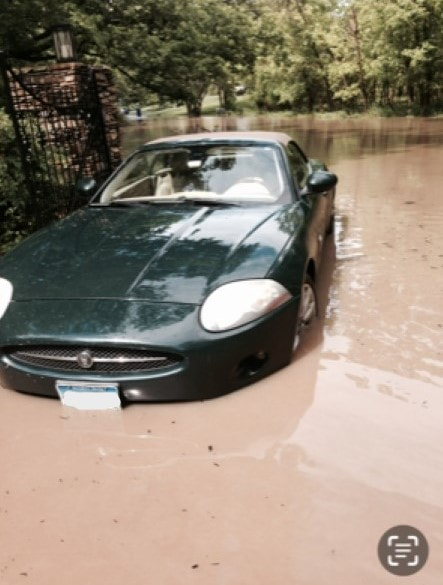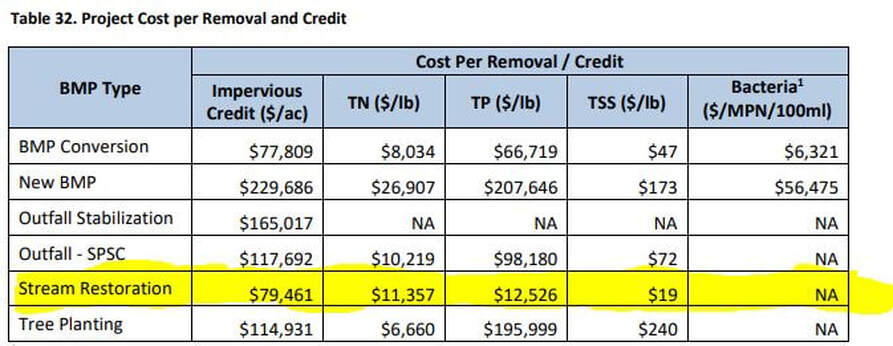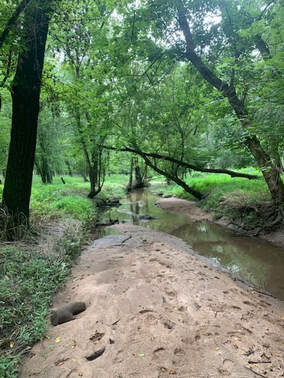[Photo Above] The Plumtree Branch behind Dunloggin Middle School where the Howard County Government is proposing to clear 4 acres of land for a stream "restoration".
Help Stop the Dunloggin Stream Restoration:
- Please sign our Petition Here: chng.it/gJDc5WkctD
- Please sign the petition in support of CB 40-2023 at https://chng.it/XjTM8WLJgS
- Please also sign a Petition to stop a stream restoration at Centennial Lake: HERE
The County meeting on September 28 was a great success, more than 100 people showed up. Please follow up and send Calvin Ball an email here and ask him to stop this project. Please send an email to our other representatives on our take action page.
County Councilwoman Liz Walsh has introduced CB 40-2023 which will remove the exemption that stream restorations have from the Forest Conservation Act. Please write to the Howard County Council here to support this bill.
NEW INFORMATION!
- New information added about the Mount Hebron Stream Restoration
- See my letter to Maryland Department of the Environment (MDE) on our Take Action page
- The county has added an additional truck path around the perimeter of the Dunloggin Middle School athletic fields which will require the clearing of 3/4 acre and the unnecessary removal of 600 additional trees.
- We need to send more letters to our elected representatives to cancel this project
Background
The Howard County government is planning on doing a stream restoration on the Plumtree Branch Stream behind Dunloggin Middle School. See the Final Plans HERE. Although restoration may sound like a good thing, this project is a very bad idea. The EPA and the state of Maryland require the counties to reduce the amount of pollution and sediment being sent to the Chesapeake Bay under the National Pollutant Discharge Elimination System (NPDES). The idea of protecting the Bay with stream restorations is not supported by good science. There may be many small studies that support stream restorations, however, in 2014 Margaret Palmer of the University of Maryland completed a meta-study of 644 stream restorations and showed that stream restorations do not work. Stream restorations are based on engineering models that make predictions that do not hold up to scientific scrutiny. The EPA's own Inspector General criticized the EPA for claiming that the Chesapeake Bay is improving. The EPA's false claims are based on predictive models rather than actual evidence of improvements. This project will destroy the woods around the stream and the habitat it provides for the fish, animals and birds that live there. These types of stream restorations do not follow the spirit of the law which is to protect the environment, and make no attempt quantify the ecological damage being done to be balanced against the supposed benefits of stream restorations.
Howard Countys own 2022 NPDES report to the state on pages 61-64 refers to various watersheds. Regarding the Wilde Lake watershed: "Overall, the stream system in the Wilde Lake watershed continues to exhibit evidence of the urban stressors affecting it and has not demonstrated measured improvement in either habitat quality or ecological stream health over the seventeen years of monitoring...Overall, implementation of projects in the watershed do not appear to have significantly improved the physical habitat in the tributary streams." Regarding the Red hill Branch watershed: "In Red Hill Branch, post-restoration monitoring results indicate a subwatershed in an overall degraded ecological condition, with little change from the first two years of pre-restoration monitoring...The biological community and habitat continue to fluctuate slightly from year-to-year, with 2022 results a slight decrease from 2021, but remain in a degraded condition and have not shown any significant improvement after restoration." In Dorsey Hall: "Two sites were added, one on Red Hill Branch at Columbia Rd downstream of all restoration activities, and one site near the downstream end of Plumtree Branch upstream of its confluence with Red Hill Branch to measure effects of stormwater coming from the untreated Plumtree Branch... The physical habitat results show that both sites are severely impacted, most likely from urban development with no evidence yet of ecological uplift after restoration." (Note: referring to the Plumtree Branch as untreated is incorrect because the county restored the unnamed tributary to the Plumtree Branch in 2017. This is the project that is just south of the Northfield /Dunloggin school athletic fields.)
The contractor doing this work will be Ecotone of Forest Hill, Maryland. On their website the CEO Scott McGill described the completion of one of their projects by saying " Within weeks after construction, wildlife began moving back into the area as owls, heron, falcon, ducks, deer, raccoon, foxes, and others became acquainted with their new home." I wonder if Mr. McGill actually saw an Owl sitting on the branch of one of the saplings he planted to replace the mature trees he cut down. Ecotone will be paid to design, build and inspect their own work to be sure it meets the design goals. In the past two years we have seen the return of bald eagles and wild turkeys to Dunloggin, this project will make their continued return less likely. Our bat population has had significant declines and this removal or their habitat will only ensure that we will see more Mosquito Joe signs in our neighborhood.
When this project was first introduced it was 1.6 million dollars. At the stream meeting hosted by the county they announced that the lower third of the project was being eliminated because the 100 year floodplain had been redrawn since they started the design of the project and there were residential properties in the redrawn floodplain. The project is now 1.8 million dollars even though it is smaller. There was no mention of the properties adjacent to the upstream reach of the project who have already suffered severe flooding of basements and the loss of a car. At the stream walk a representative of the contractor was trying to explain the concept of "reconnecting the stream to the floodplain." He pointed to the floodplain near Chatham Road and said that if this area floods three times a year now it will probably flood ten times a year after the project.
Howard Countys own 2022 NPDES report to the state on pages 61-64 refers to various watersheds. Regarding the Wilde Lake watershed: "Overall, the stream system in the Wilde Lake watershed continues to exhibit evidence of the urban stressors affecting it and has not demonstrated measured improvement in either habitat quality or ecological stream health over the seventeen years of monitoring...Overall, implementation of projects in the watershed do not appear to have significantly improved the physical habitat in the tributary streams." Regarding the Red hill Branch watershed: "In Red Hill Branch, post-restoration monitoring results indicate a subwatershed in an overall degraded ecological condition, with little change from the first two years of pre-restoration monitoring...The biological community and habitat continue to fluctuate slightly from year-to-year, with 2022 results a slight decrease from 2021, but remain in a degraded condition and have not shown any significant improvement after restoration." In Dorsey Hall: "Two sites were added, one on Red Hill Branch at Columbia Rd downstream of all restoration activities, and one site near the downstream end of Plumtree Branch upstream of its confluence with Red Hill Branch to measure effects of stormwater coming from the untreated Plumtree Branch... The physical habitat results show that both sites are severely impacted, most likely from urban development with no evidence yet of ecological uplift after restoration." (Note: referring to the Plumtree Branch as untreated is incorrect because the county restored the unnamed tributary to the Plumtree Branch in 2017. This is the project that is just south of the Northfield /Dunloggin school athletic fields.)
The contractor doing this work will be Ecotone of Forest Hill, Maryland. On their website the CEO Scott McGill described the completion of one of their projects by saying " Within weeks after construction, wildlife began moving back into the area as owls, heron, falcon, ducks, deer, raccoon, foxes, and others became acquainted with their new home." I wonder if Mr. McGill actually saw an Owl sitting on the branch of one of the saplings he planted to replace the mature trees he cut down. Ecotone will be paid to design, build and inspect their own work to be sure it meets the design goals. In the past two years we have seen the return of bald eagles and wild turkeys to Dunloggin, this project will make their continued return less likely. Our bat population has had significant declines and this removal or their habitat will only ensure that we will see more Mosquito Joe signs in our neighborhood.
When this project was first introduced it was 1.6 million dollars. At the stream meeting hosted by the county they announced that the lower third of the project was being eliminated because the 100 year floodplain had been redrawn since they started the design of the project and there were residential properties in the redrawn floodplain. The project is now 1.8 million dollars even though it is smaller. There was no mention of the properties adjacent to the upstream reach of the project who have already suffered severe flooding of basements and the loss of a car. At the stream walk a representative of the contractor was trying to explain the concept of "reconnecting the stream to the floodplain." He pointed to the floodplain near Chatham Road and said that if this area floods three times a year now it will probably flood ten times a year after the project.
The county government chose this project because it is a large piece of county owned property with easy access that does not require negotiations with anyone. The Chesapeake Bay Foundation has serious questions about stream restorations, as discussed in this podcast Here. It is 12 minutes long but their concerns are mostly near the end. There is an old sewer main running under the stream that has had problems in the past that resulted in three children being hospitalized. Will this sewer line need repair or replacement soon? See Baltimore Sun story Here.
[Above video] The Bird in the above video broke its wing on the safety fence around the Mount Hebron Stream Restoration.
The table below is from a Howard County document titled Countywide Implementation Strategy 2017. Howard_County_CIS_2017-12-18.pdf (squarespace.com)
The county is required by law to reduce the amount of sediment and pollutants going to the Bay. BMPs are Best Management Practices which are different things that can be done to reduce sediment and pollutants such as stream restorations, stormwater management ponds, and planting trees. I am not sure what BMP conversions are, possibly converting dry stormwater management ponds into wet ones, but they are probably a limited number of opportunities for that. The big takeaway from this table is that it explains why the county does so many stream restorations, it is the cheapest way to meet their regulatory obligations to save the Bay. Stormwater management ponds which reduce the amount of water getting to the streams in the first place are the better alternative, but they are New BMP which cost more in the short term. Without reducing the water coming from Rt 70, Rt. 40, Rt. 29 Chatham Shopping Center, Sprouts, and Hcpss properties the storm flows will only get worse and the stream will continue to be filled with sediment. This table purports to be some sort of cost benefit analysis but it shows a fundamental flaw in the whole system, the environmental cost is not even acknowledged.
The table below is from a Howard County document titled Countywide Implementation Strategy 2017. Howard_County_CIS_2017-12-18.pdf (squarespace.com)
The county is required by law to reduce the amount of sediment and pollutants going to the Bay. BMPs are Best Management Practices which are different things that can be done to reduce sediment and pollutants such as stream restorations, stormwater management ponds, and planting trees. I am not sure what BMP conversions are, possibly converting dry stormwater management ponds into wet ones, but they are probably a limited number of opportunities for that. The big takeaway from this table is that it explains why the county does so many stream restorations, it is the cheapest way to meet their regulatory obligations to save the Bay. Stormwater management ponds which reduce the amount of water getting to the streams in the first place are the better alternative, but they are New BMP which cost more in the short term. Without reducing the water coming from Rt 70, Rt. 40, Rt. 29 Chatham Shopping Center, Sprouts, and Hcpss properties the storm flows will only get worse and the stream will continue to be filled with sediment. This table purports to be some sort of cost benefit analysis but it shows a fundamental flaw in the whole system, the environmental cost is not even acknowledged.
There are many alternatives to this work that the county should be doing. The Army Corps of Engineers and the Maryland Department of the Environment (MDE) say that localities should not overly rely on stream restorations to reduce the sediment and pollutants going to the bay. Instead localities should reduce the amount of water entering the stream, upstream of where the erosion is occurring.






